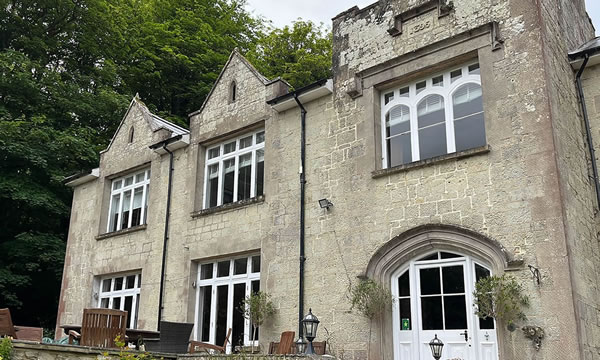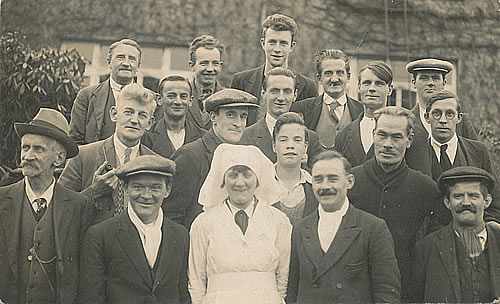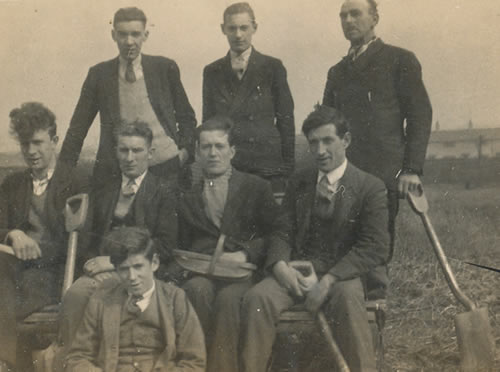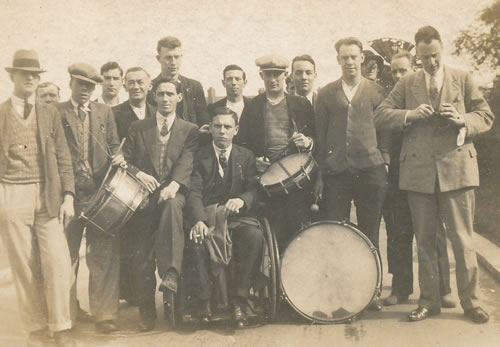| Harold Burgess and TB | |
|
Memorabilia
|
When Harold Burgess was being treated for tuberculosis in 1930, it coincided with the arrival at Colindale Hospital of Dr Frederick Heaf as Medical Superintendent. Dr Heaf had spent some time at Colindale earlier in his career and when he returned it was as a recognised expert in the treatment of TB patients. Indeed, some years later he was to have the Heaf Test for TB, with its six-needle injection much dreaded by schoolchildren, named after him. In 1931 Dr Heaf delivered four lectures on TB at the British College of Nurses and later in the year they were published in The British Journal of Nursing. I have used extracts from these lectures (in italics) to complement the account of Harold’s recovery described in family letters (in quotation marks). The intentions and the reality do not always match. In Pulmonary Tuberculosis we find that the majority of cases are young adults. The pulmonary infection shows its greatest activity between the ages of twenty and forty, just the period when an individual is of greatest value to the State, and the time of life when his activities should be greatest. The sanatorium has now become to be recognised, almost universally, as the proper place to treat Pulmonary Tuberculosis. Harold was 23 when he fell ill and by September 1930 he was staying at The Hermitage, a large converted house on the Isle of Wight. He made a sketch to enclose in a letter. 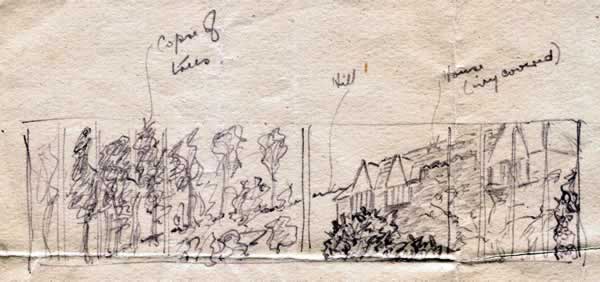 The general outline is still recognisable today, including the "copse of trees" and "house (ivy covered)". The "Hill" is St. Catherine's Down, near Ventnor.
It looks like the ivy has been cleared away.
A group photograph of patients taken at The Hermitage (complete with ivy). Harold is the tallest of the patients, standing in the back row.
..it is generally necessary to observe him for about three or four weeks, during which time temperature and pulse charts are kept, a record of the weight is made,.. Harold wrote on Tuesday 4 October 1930 "I shall have to go over to be weighed shortly so I shall be able to let you know my weight. One of the fellows weighed me last night with my jacket and boots on and I went 12 st 5 lb. That is heavier than any weight of mine previous to coming here… I have just been weighed and the sister made it 12 st again but I know it was really 12 st 0½ lb because I weighed myself just before. Anyway I am keeping on the move so I sha’n’t expect to gain much. Yesterday the Doc. promoted me to grade 4 so I’ve only got 2 grades to pass now, grades 4 and 5, to go to 6. I don’t suppose I shall reach grade 6 though, as I certainly sha’n’t stay here 12 months for that." So, little by little, the amount of exercise is increased, always being controlled by records of temperature and pulse: First through the stages by which the patient passes from absolute rest to getting up all day; then through the walks from half-mile to six miles a day; and finally from very light work, such as carrying a small basket with earth or picking up paper litter, to heavy work, such as wheeling a barrow, mowing and rolling lawns and digging.
A hospital working party complete with spades and a small basket. Harold is sitting at the far left sporting a fine head of hair that was much depleted by middle-age.
By January 1931 Harold had returned to London to be treated at Colindale Hospital. The houses in the background suggest this photograph was taken at Colindale rather than The Hermitage.
Patients very quickly become immune to low temperatures and can dispense with fires throughout the winter. Exposure to dampness is not desirable, and open-air pavilions should be sheltered from the prevailing winds. I think a more moderate view is now taken of fresh-air treatment, and a certain amount of heat is not considered detrimental, but sitting over a fire should be absolutely forbidden. Written from Ward 2, Bed 26, Colindale Hospital Wednesday 21 January 1931 "You will see that the first line of my address is changed again. You see, in this place we go into a receiving ward first, then to a sick ward and from there to a convalescent ward. We heard last Monday morning that they were expecting more than a dozen new patients on Tuesday and as the only receiving ward has only 16 beds most of us would be moved. They moved about 14 altogether and of those I was the only one that went straight to a convalescent ward Monday morning. The Sister of Ward 9 said I ought to go onto a balcony and as I said I’d like to, she spoke to the Medical Superintendent. When he came round he asked if I was on grade at The Hermitage and then marked my chart for a balcony bed in this Con. Ward. So pray for warm weather Darling! Still I’ve been here since Monday afternoon and I haven’t felt cold yet. The view from here is not by any means so good as it was from either St Giles or The Hermitage. The balcony overlooks the Concert Hall in which we periodically have concerts." Two views of the balcony accommodation. 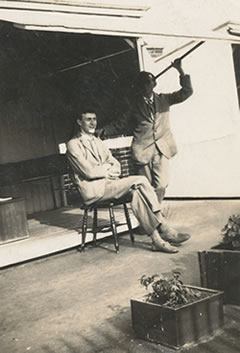 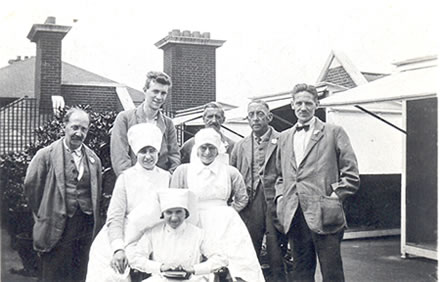 "It is lovely out here this morning. I’ve had the canopy up all night (as I have the previous 3 nights) and as there’s no frost and no mist…
" "It is lovely out here this morning. I’ve had the canopy up all night (as I have the previous 3 nights) and as there’s no frost and no mist…
"
The chief rest hours are before midday dinner and supper, and there is another rest for those who are in the early stages of treatment, in the afternoon; when resting patients must be on their beds and not talk or read. Smoking and games are rigidly controlled, and patients are in bed early and punctually. "I am finishing this letter this morning, Wednesday morning. By the time I’d finished getting all set for bed (hot bottle etc.) it was quarter to eight and at eight I was so tired I decided to turn in and finish this, this morning. It was rather fortunate that I did because Dr. Heaf came round at 9 o’clock and found several fellows still sitting round the Day-room fire. I believe he spoke a few “feeling” words to them. I have been sitting in the Day-room at 9.00 p.m. before now so I was extremely lucky this time." The diet consists of plain, good, nourishing food, in such quantities as to satisfy the patient, but not to overtax his digestion. Food of any description is forbidden between meals, and it has been found unnecessary to issue milk as a drink; in fact, in cases with abdominal complications, it is given very sparingly indeed, as it definitely aggravates the symptoms. Fruit, vegetables and salads are essential; meat is an important item and should be lightly cooked. Patients are encouraged to eat fat, but nearly all of them have a natural dislike for it. "The food here is far better than at The Herm. though. We had cold ham for breakfast, roast beef and two veg. with prunes and blanc-mange for dinner. Yesterday we had bacon and fried bread for brekker, cottage pie and apple pie for dinner and a really nice piece of really nicely fried fish for supper. All that I’ve had here has been nicely cooked in fact. Tea time we only get a mug of tea and 2 slices of bread and dripping or 3 biscuits and that’s not much for me but I have to make up supper time. I’ve also been getting a packet of biscuits from the canteen every day and that helped."
Are packets of biscuits consistent with food being forbidden between meals I wonder?
Hospital entertainment appears to be a serious matter. Once again, Harold at 6ft. 2in. is the tallest in the back row.
The latest dated letter referring to Harold's TB is one addressed to him at Ward 2, Colindale from his mother in March 1931 in which she wrote "Will you be out on Sunday, I don't think Cyril said. He told me you were on grade 4, so I suppose you are pushing the barrow, don't overdo it." In an undated letter Harold referred to "nine months idleness" and this is consistent with the following comment in a letter written in June 1930 by his future mother-in-law to her daughter, Rose: "I was very pleased to hear you found Harold better and truly hope he will continue so... Pray God to comfort you and give Harold health and strength to battle through". Rose and Harold were married on 25 November 1933.
|
| Top of Page |
